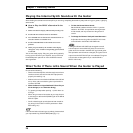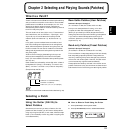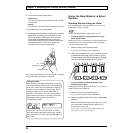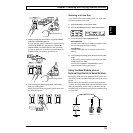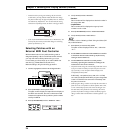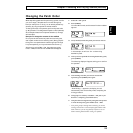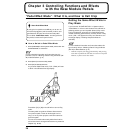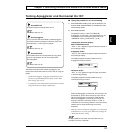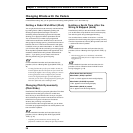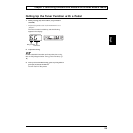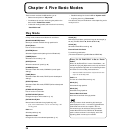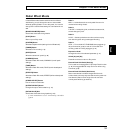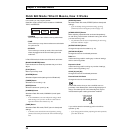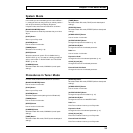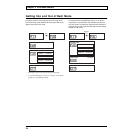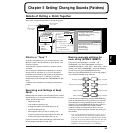
28
Chapter 3 Controlling Functions and Effects with the Base Module Pedals
Changing Effects with the Pedals
In Pedal Effect mode (p. 26), you can get different effects by pressing Pedals 1 to 4 in the follow way.
Getting a Pedal Wah Effect (Wah)
You can get several of the most commonly used wah effects
by pressing Pedal 1 (WAH). Repeatedly pressing and
releasing the pedal produces changes in the sound
resembling those produced by a guitar wah-wah pedal,
allowing you to apply this effect to synthesizer sounds.
You can choose from a number of pre-programmed
variations that use different combinations of rate of sound
change, degree of change, panning, how different the sound
becomes, and so on. These can then be saved in each patch.
In addition, when you select “Modulation” in “WAH TYPE,”
you will hear a deep vibrato (undulating or wavering pitch)
when the pedal is pressed instead of wah-type effects. This
creates the mechanical-sounding vibrato characteristic of
synths — if you prefer, you can create a more natural-
sounding vibrato using your guitar fingering.
For more detailed information and instructions for this
procedure, refer to “Selecting Wah Types (WAH TYPE)” (p.
43).
* You may find that when you first press Pedal 1 (WAH), the
sound is different than when the patch was first selected. The
sound may be muffled, or have a strange quality to it. Return
to the original patch, switch to a different patch, and then
return to the original patch again. If a bank shift pedal is
connected, you can return to the original patch by pressing the
bank down pedal while still in Pedal Effect mode.
Changing Pitch Dynamically
(Pitch Glide)
Press Pedal 2 (P-GLIDE) to get a pitch glide effect. This effect
creates continuous changes in pitch over variable time
intervals, long or short. With chords—since you can glide
while maintaining the harmonic intervals within the chord—
this differs from a guitar’s vibrato arm/vibrato bar/
whammy bar, providing a unique effect.
As for the time duration and glide intervals, you can select
from seven pre-programmed pitch rise and fall patterns, and
then save them in patches.
For more detailed information and instructions for this
procedure, refer to “Selecting Pitch Glide Type (GLIDE
TYPE)” (p. 44).
* Depending on the selected tone, the tone settings, and
performance conditions, the width of the effect may be limited.
Holding a Synth Tone After the
String is Stopped (Hold)
Press Pedal 3 (HOLD) to activate the Hold function. When
you use this effect, the synthesizer sound continues to play
even after the guitar string has stopped vibrating.
You can select from a number of variations — hold the
synthesizer chord while the guitar plays a melody, hold only
one of two layered tones, hold only Strings 5 and 6, and more
— and then save them in patches.
For more detailed information and instructions for this
procedure, refer to “Selecting Hold Type (HOLD TYPE)” (p.
45).
* When the arpeggiator is on, the behavior and available
variations for the Hold function are different than when the
arpeggiator is off.
For more detailed information and instructions for this
procedure, refer to “Effective Use of the Hold Function
During Arpeggios” (p. 76).
<Some Notes About the Display>
When Pedal 1 (WAH) is pressed
“UAH” or “Mod” appears in the three-digit display.
When Pedal 2 (P-GLIDE) is pressed
“P.GL” appears in the three-digit display.
When Pedal 3 (HOLD) is pressed
“HLd” appears in the three-digit display.



